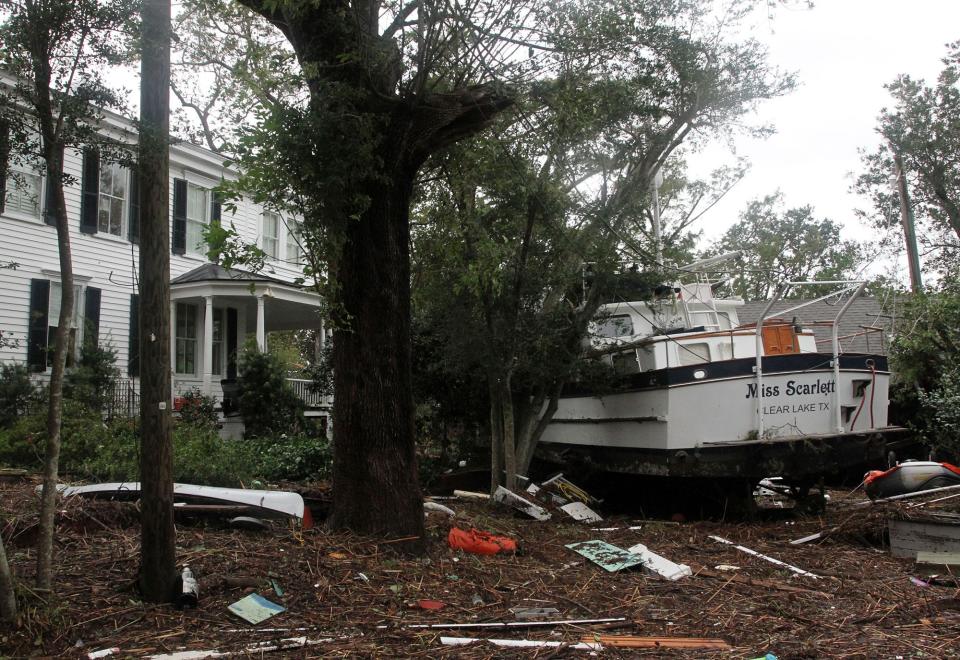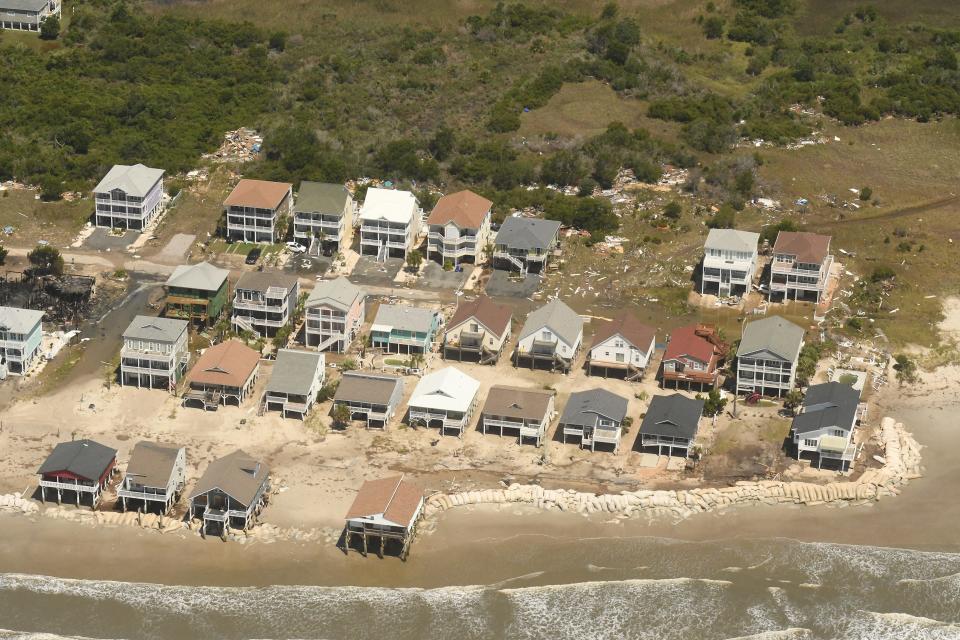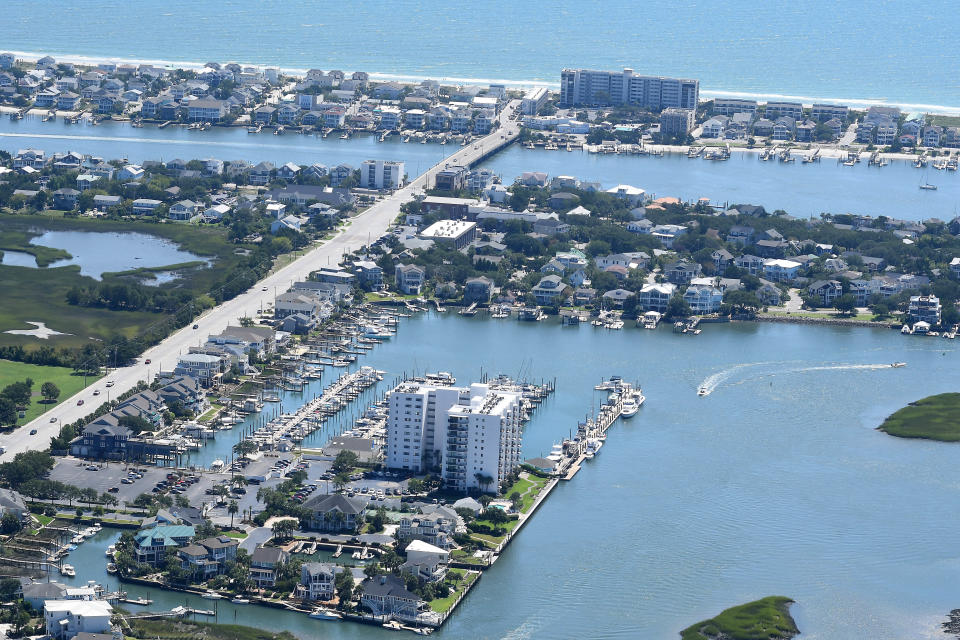What rising sea levels mean for where and how we live along the NC coast
With several recent academic studies warning of increased sea-level rise along the North Carolina coast and the June 1 start of hurricane season just around the corner, the old question of whether we can continue with development along the oceanfront as normal − or at least as we have been building − is garnering new attention.
For decades, state regulators have used historical erosion rates to determine how far back from the first stable line of natural vegetation, often referred to as the dune line, a structure can be built. These setbacks are based on average long-term erosion rates that reflect changes in North Carolina's shoreline over nearly half a century. The rules are more stringent in areas near inlets that are notoriously unstable and can quickly erode as inlet channels move.
While some areas of the state's 300-mile shoreline are quite stable, especially those that receive regular beach nourishment projects, others are rapidly dwindling. Officials with the Cape Hatteras National Seashore have recorded erosion rates around Rodanthe, a small village near the northern tip of Hatteras Island, of more than 13 feet annually in recent years.
Pictures of oceanfront homes in Rodanthe, four in the past 15 months, washing away into the encroaching Atlantic have made national and international news and refocused attention on the dire erosion situation along some parts of the Outer Banks.
What did the new studies say?
The studies found sea-level rise along the North Carolina coast is occurring faster than expected, and at a higher pace than most other areas of the United States.
Researchers from Tulane University, in a study published in late March, found sea-level rise of about 0.5 inches a year since 2010 off the Southeast and Gulf coasts, which is three times the global average. While that might not sound like a lot, the U.S. Environmental Protection Agency says average sea level has risen by 0.14 inches since the early 1990s.

Rising waters: New studies show 'unprecedented' sea-level rise along the North Carolina coast
An annual look by the Virginia Institute of Marine Science at William & Mary at 32 tide gauges along the U.S. coast, also released in March, showed seas continuing to rise, with areas of the Mid-Atlantic coast showing the highest increases. The study projected that by 2050 Wilmington could see an increase of up to 2.26 feet in its high tides compared to 1992 levels.
So can we 'retreat' from the coast?
Yes. But there are plenty of reasons why that's not the favored option, or even practical, in many cases.
In many beach towns moving a threatened oceanfront home to another lot isn't feasible because everything has already been developed. Many oceanfront homes, especially those built with renting out as their primary purpose, also are too big to be moved.

Then there's the financial considerations. Prices generally increase the closer you are to the ocean, meaning removing or demolishing a beachfront property can cost the homeowner and coastal towns and counties a lot of lost rental and tax revenue, not to mention the potential public relations hit.
Washing away: As another Outer Banks home washes away, the impacts could be felt along the NC coast
That's led to increased interest in taking steps to stabilize beach areas seeing increased erosion, whether through hardened structures like sandbags and terminal groins to beach nourishment projects.
New homes also are being built to higher standards, and simply higher on stilts, to better weather the rising seas and expected increase in strength of future tropical weather systems due to climate change.
But Dr. Robert Young, director of the Program for the Study of Developed Shorelines at Western Carolina University, said rebuilding back the same way after a storm strike or just severe erosion doesn't make economic or practical sense knowing what we know about likely future impacts along the oceanfront.
“The root of the problem is we still spend tens of millions of dollars-plus on storm rebuilding and resilience, but we don’t ask those communities to do anything differently," he said, referring to post-storm rebuilding efforts in many coastal areas. "We have those opportunities, but we just don't take them."
Towns that get beach nourishments are stable, right?
Like many things, a hurricane strike can change things quickly. But yes, towns that see periodic injections of fresh sand historically have more stable oceanfront areas than those that don't.
Beach nourishment, though, is expensive. And it has to be done every few years to really work. While many beach towns, notably on the Outer Banks, have recently seen new sand, it isn't known when the next one might come since local communities generally have to foot the bill − sometimes with the state's help − if it's not a federal project.

And beach nourishment projects aren't cheap. Dare County officials told Rodanthe residents in January that the county couldn't afford a nourishment project in the unincorporated village, especially after helping fund projects in several other Outer Banks communities. North Topsail Beach also has abandoned plans to participate in a beach nourishment project with Surf City due to cost concerns.
Sand shortage: Wrightsville Beach prepares to weather another hurricane season as it waits for sand
Even if a town is part of a federal beach nourishment project, things don't always go according to plan. Wrightsville Beach, which has had an Army Corps of Engineers' beach project since the 1960s, has been waiting more than two years for fresh sand over disputes about where the new beach material should be dredged.
Are people paying a premium to live at the coast?
In short, yes. The consensus, however, is it's not because of the risk of sea-level rise and other factors tied to climate change, like higher insurance rates, but because there simply isn't enough oceanfront property for everyone who wants to live there.
Using data from the real estate website Zillow, the online data website Stacker determined that Wrightsville Beach was the North Carolina community with the fastest growing home prices.

Pricey properties: Buying a home? These are the most, and least, expensive ZIP codes in New Hanover County
The site said home values in the popular New Hanover County beach town averaged nearly $1.35 million in March 2023, with prices up 8.6% over one year and 82% over five years. Within the list's Top Ten, Topsail Beach came in at No. 3, Bald Head Island No. 4, Holden Beach seventh, St, James eighth, and North Topsail Beach ninth.
Reporter Gareth McGrath can be reached at GMcGrath@Gannett.com or @GarethMcGrathSN on Twitter. This story was produced with financial support from 1Earth Fund and the Prentice Foundation. The USA TODAY Network maintains full editorial control of the work.
This article originally appeared on Wilmington StarNews: Facing the challenge of rising seas along the NC coast

